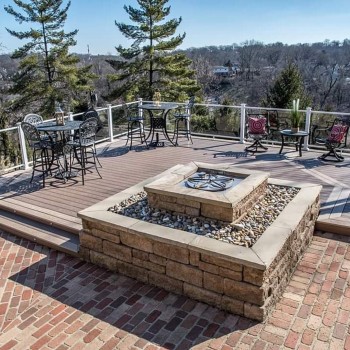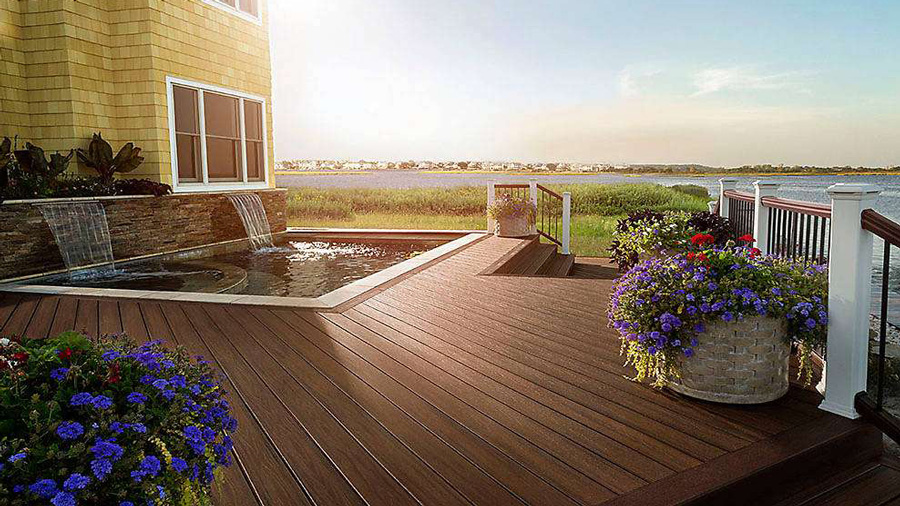How To Create Strong and Unique Patio Paver Patterns
One of the best ways to totally transform the look of your deck or patio is to resurface it with a distinctive pattern of outdoor pavers. When laying pavers, the possibilities for looks and patterns are nearly endless - so how do you pick the perfect paver pattern for your space and get started?
Below, we'll run through 6 beautiful deck paver patterns you can create in your space, explaining how to set up each one using Aspire Pavers by Brava and the included easy-to-use installation grid.
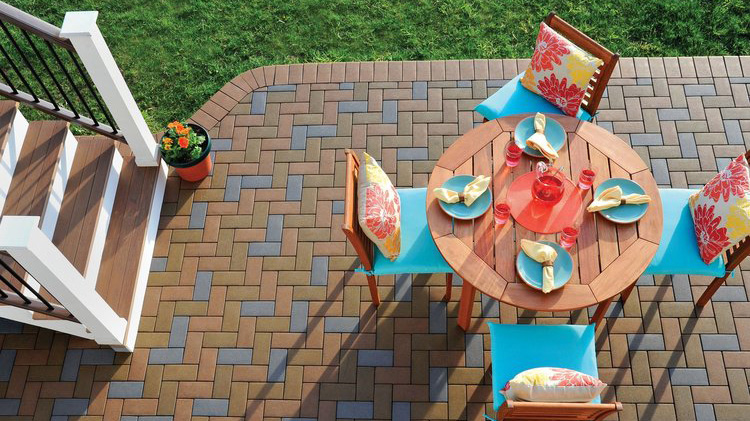
Here are six unique paver patterns you can create in your backyard patio or deck:
- Herringbone
- Basketweave
- Running bond
- Block Lattice
- Soldiered
- Plainweave
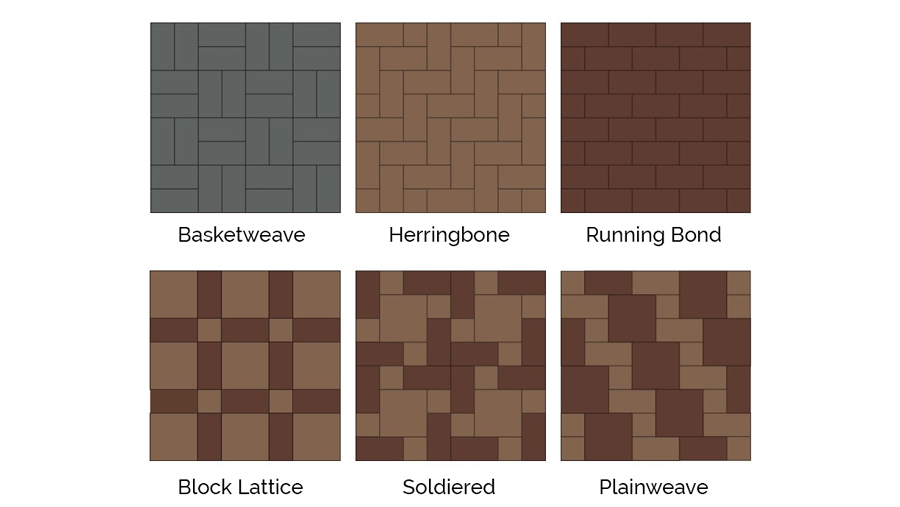
Read on to learn how to create all six!
Pro Tip: Make Sure Your Paver Laying Patterns Overlap Grids
We'll describe how to create all of the paver patterns below using Aspire Pavers by Brava, which come with an installation grid to keep pavers in place after you've laid them. You could also recreate these paver design ideas with traditional stone pavers, though you'll have to be more careful to keep everything square without the grid to guide your design.
These paver pattern ideas all use a mix of rectangular and square pavers:
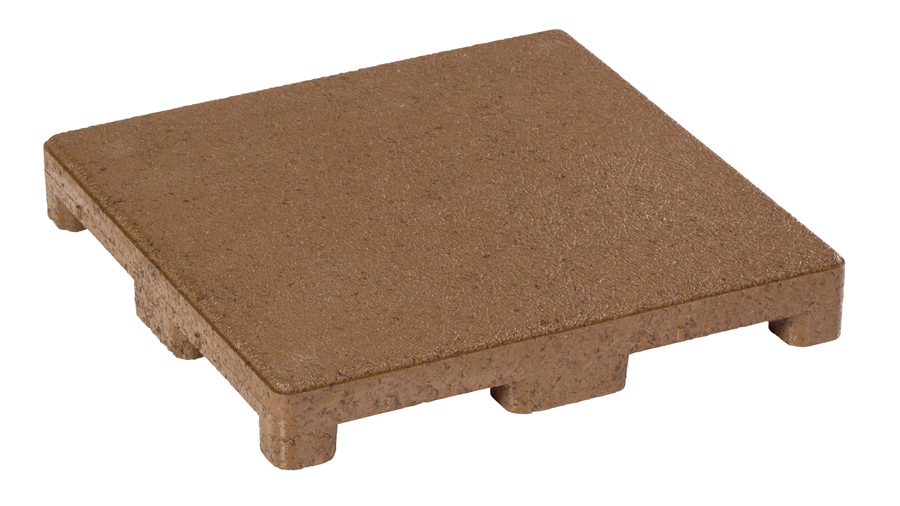
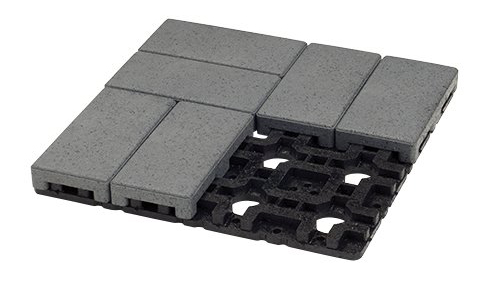
The installation grid is a huge benefit - it keeps pavers from moving or uprooting, and it also keeps your pattern perfectly square and even. That's especially helpful when laying pavers across a large or long space..
The important thing is to make sure your pattern includes pavers that overlap multiple grids, locking them together. This will keep your pavers from slowly sliding apart over time as guests walk across them. All of these paver patterns for patios and decks are designed to lock each individual installation grid to the grids around it for maximum strength.
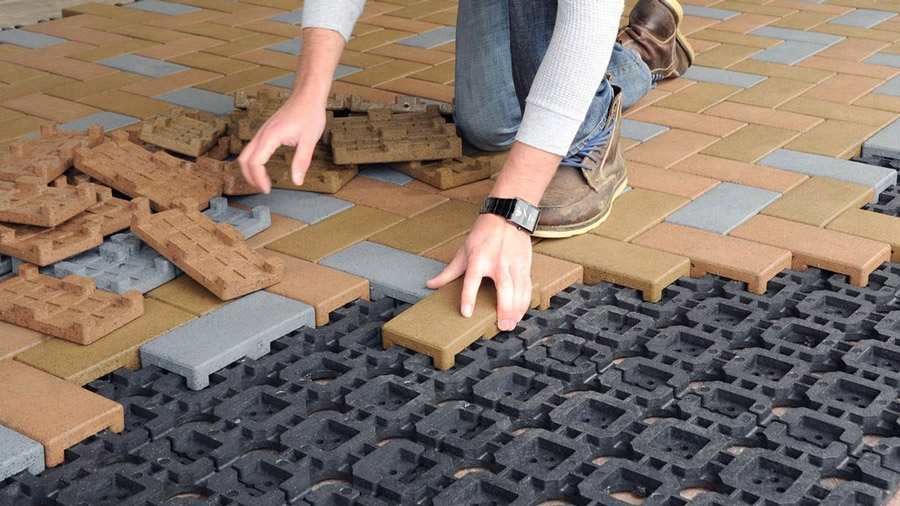
How To Create DIY Patterns For Pavers:
Herringbone Paver Pattern
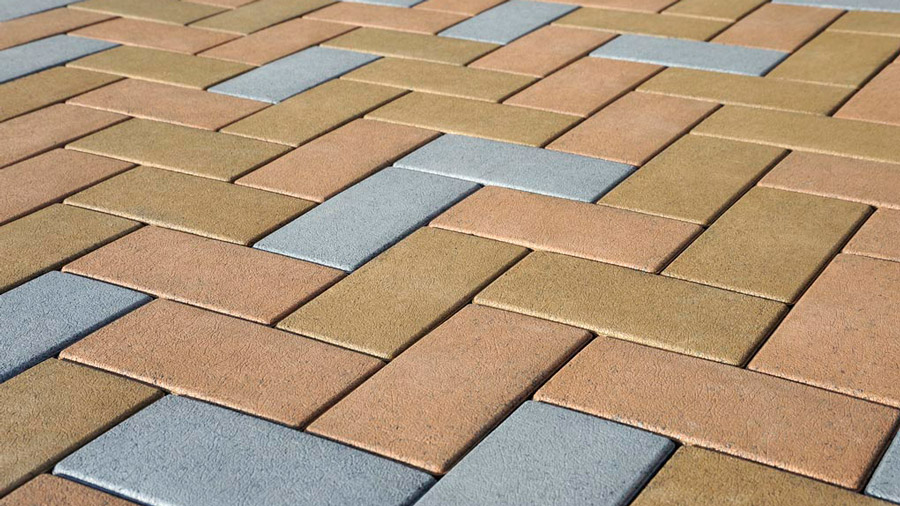
We'll start with one of the most widely-used and versatile paver designs for a patio or deck: the herringbone.
The herringbone pattern is the strongest paver pattern, with each individual paver held in place by the six different pavers all around it. A herringbone layout will lock all of your underlying grids together and will keep your pavers firmly in place even with heavy foot traffic.
How To Install A Herringbone Pattern
For the herringbone look, install your grids in a square, as shown below. Start at the corner and lay rectangular pavers at right angles:
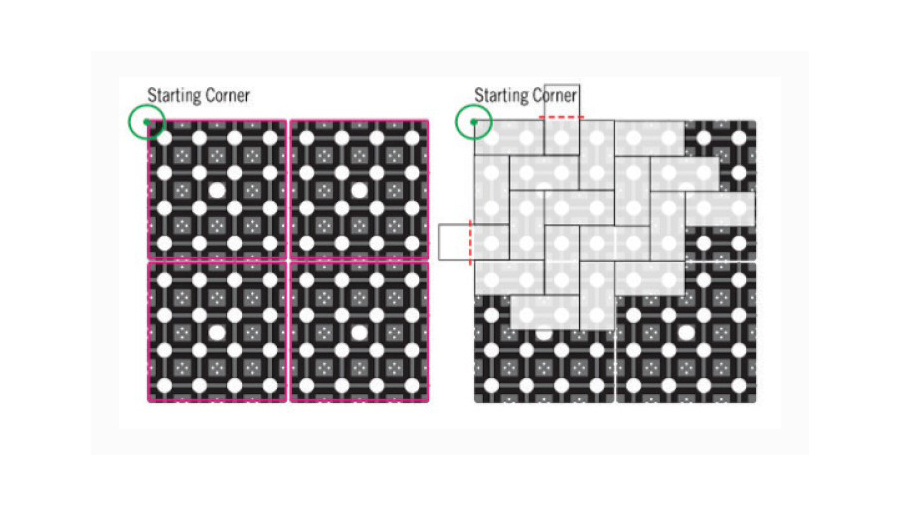
At the edges of your space, you can cut down the pavers that extend beyond the edge of the grid. Across the rest of the space, those pavers will overlap and hold two grids firmly together.
You can mix up colors, as shown in the photo above. But the herringbone pattern also has enough visual appeal on its own to work great with a single color, like the beautiful red deck below:
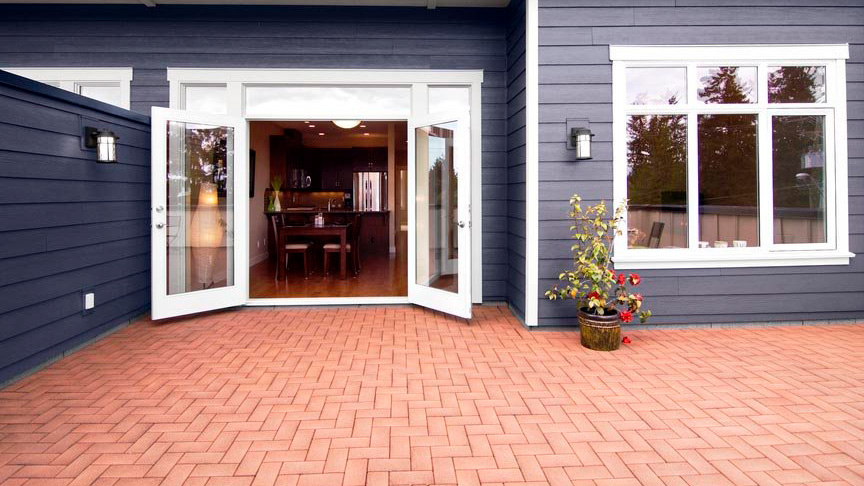
Basketweave Paver Pattern
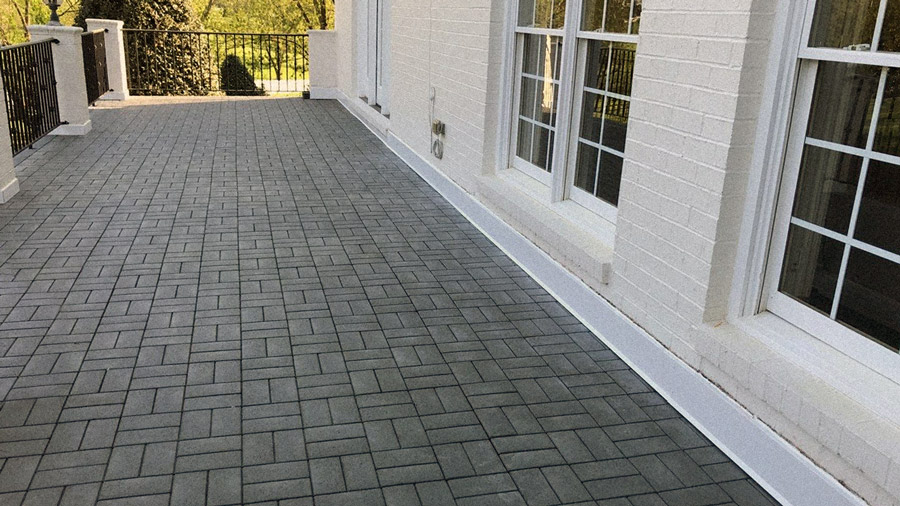
A basketweave pattern preserves lots of long, extended lines to make your space look and feel huge. But by alternating the direction of each set of two tiles, it adds a little more complexity than a typical deck with long individual boards running the same direction.
How To Install A Basketweave Pattern
To make basketweave paver patterns work, start by cutting down the first grid you use. Take 4 inches off in both directions, as shown by the dotted lines in the image on the left below:
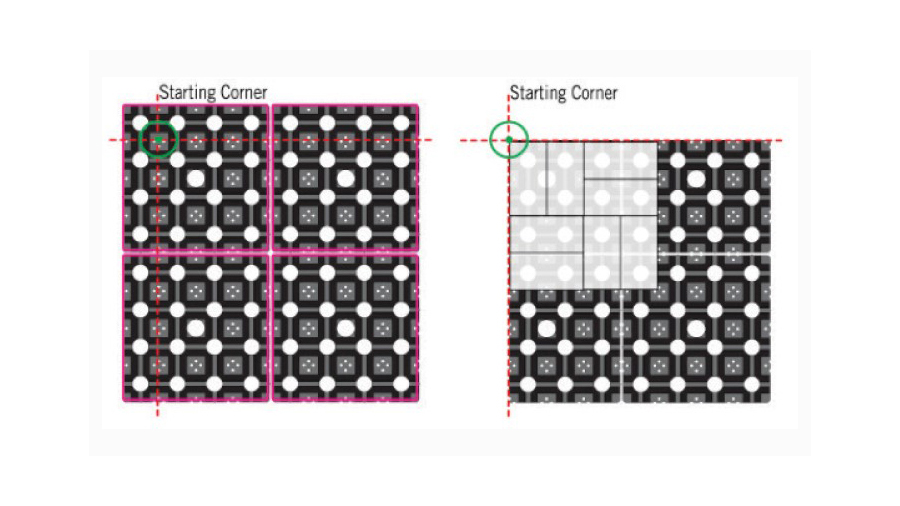
Then, when you lay your first eight tiles, they'll overlap onto the next grid, firmly locking everything together. From there, you can continue your pattern across the rest of the space.
You can create a monochromatic basketweave pattern like the deck above. But you can also alternate colors for a more custom look, like the box-within-a-box scheme below:
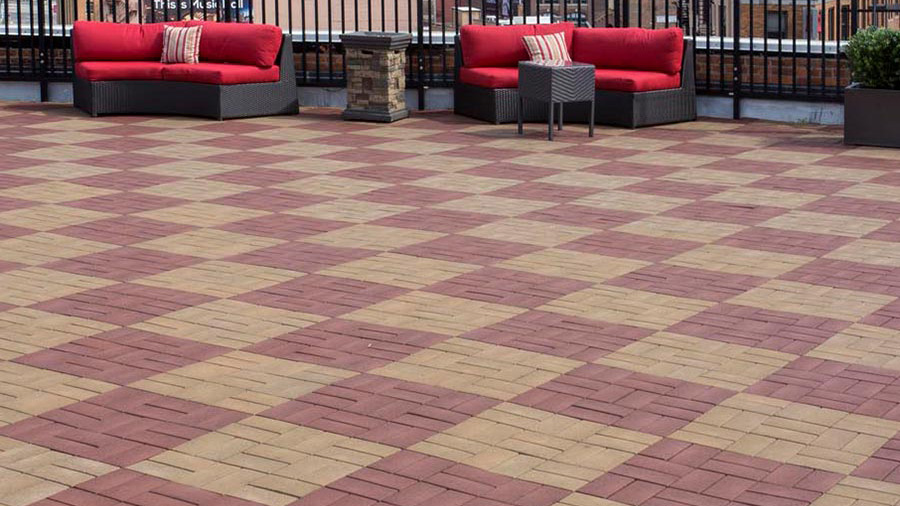
Running Bond Paver Pattern
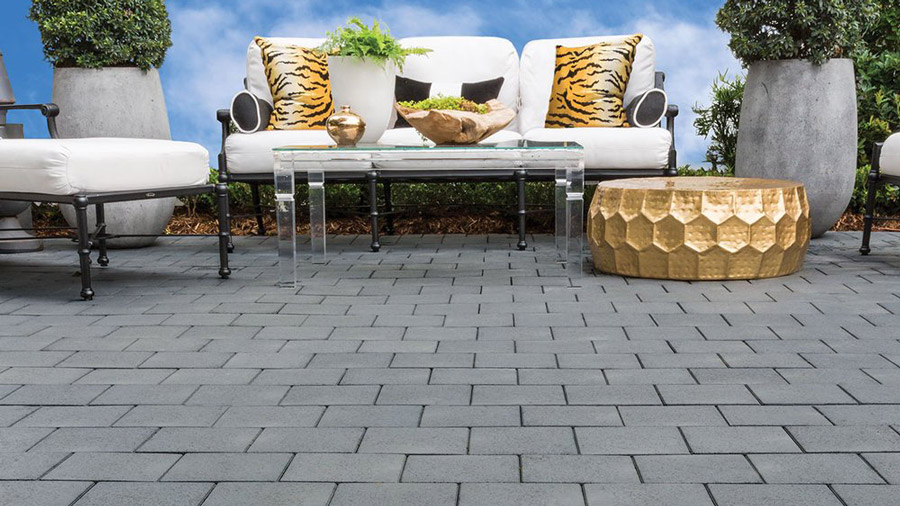
The running bond is another classic paver pattern that mimics the layout of a brick wall with each paver offset from the previous row and matching the row before that.
The result is a little more visual intrigue than a classic stack bond pattern (where each row would be identical, without the offsetting seams). It's also stronger, with each paver held in place by six different pavers around it.
How To Install A Running Bond Pattern
For a running bond layout, you'll need to start with your grids staggered, as shown in the image below on the left. This makes sure that your pavers overlap multiple grids to keep everything locked in place. You can cut off the top portion of the extending grid and use it at the bottom of your layout.
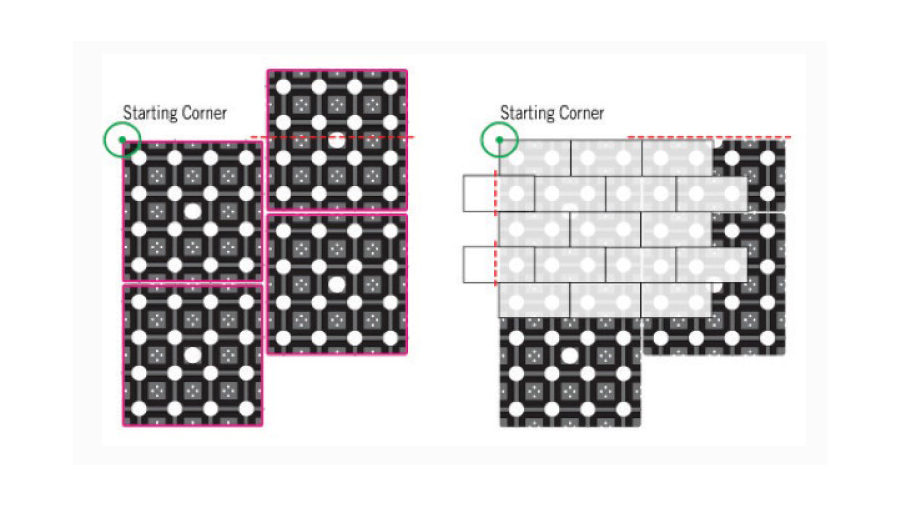
You can also cut the pavers in half where they extend past the first grid. Once again, you can save material by using the other half of the paver on the other side of your pattern.
Block Lattice Paver Pattern
Now, we'll leave the more traditional paver patterns to look at a few more complex options. These next three will all combine rectangular patterns with the larger 8-inch by 8-inch square pavers.
A block lattice pattern features a large square paver prominently in the middle, framed by smaller rectangular and square pavers.
How To Install A Block Lattice Pattern
Your installation grids can sit square for this pattern, without needing any trimming or offsetting. Start with a big square in the corner, then surround it with rectangles on the long sides and small squares at the corners:
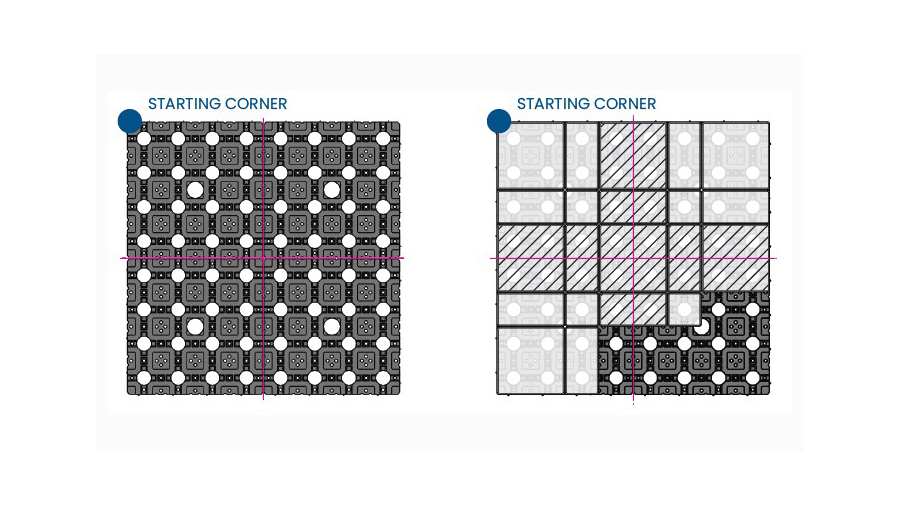
By the time you get to the next row of large squares, they'll straddle the boundary between grids, locking everything together.
If you're installing a block lattice layout, you'll want to buy and use this ratio of paver shapes:
- 44.4% large square (8x8) pavers
- 11.1% small square (4x4) pavers
- 44.4% rectangular 4x8 pavers
You can always give our team a call at 1-888-824-5316 to plan your project and make sure you get the right amount of each shape and color for the look you want.
Soldiered Paver Pattern
A soldiered pattern is very similar - it's built around a large square paver surrounded by smaller rectangles. But instead of the block lattice aesthetic, which features a lot of joints with four square corners meeting, the soldiered pattern offsets the smaller rectangles to create more of a "swirl" around the large square.
How To Install A Soldiered Pattern
For the soldiered pattern, you'll need to trim your starting grids, cutting them in half on both the top and side of your starting space, as shown in the dotted lines below. (You can use the other halves of the grids at the other end of your space to avoid wasting material).
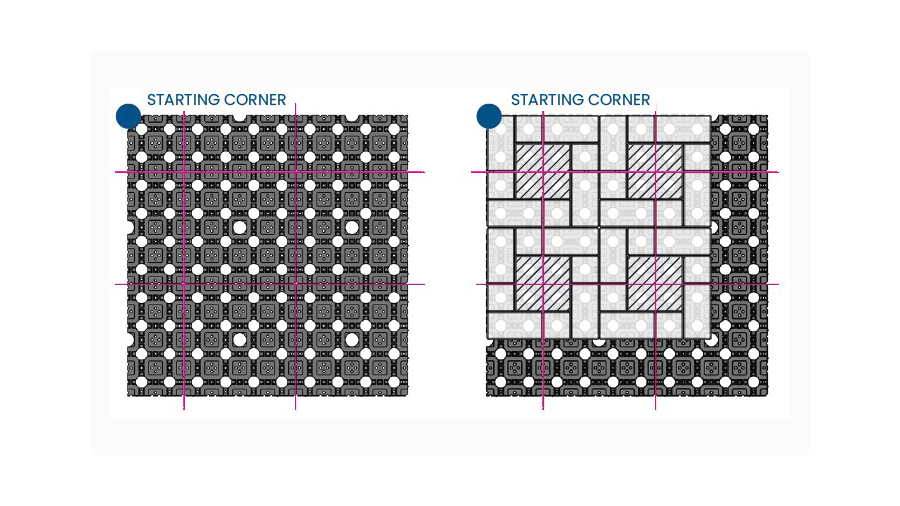
Your first large square tile will overlap the four corners of your starting grids for maximum stability. Then surround the large square tile with a pattern of alternating rectangle and small square tiles.
If you're installing a soldiered layout, you'll want to buy and use this ratio of paver shapes:
- 25% large square (8x8) pavers
- 25% small square (4x4) pavers
- 50% rectangular 4x8 pavers
You can always give our team a call at 1-888-824-5316 to plan your project and make sure you get the right amount of each shape and color for the look you want.
Plainweave Paver Pattern
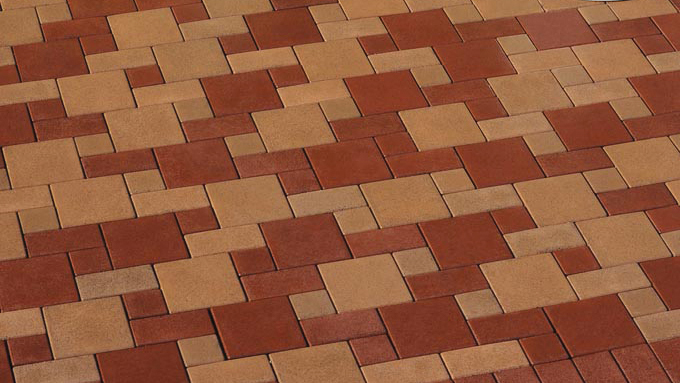
The plainweave pattern looks complex but isn't any more difficult than the other paver patterns we've hit so far. You can alternate colors for a look that's especially eye-catching.
How To Install A Plainweave Pattern
For the plainweave layout, there's no need to cut down any installation grids. Just set them up in a square as shown below:
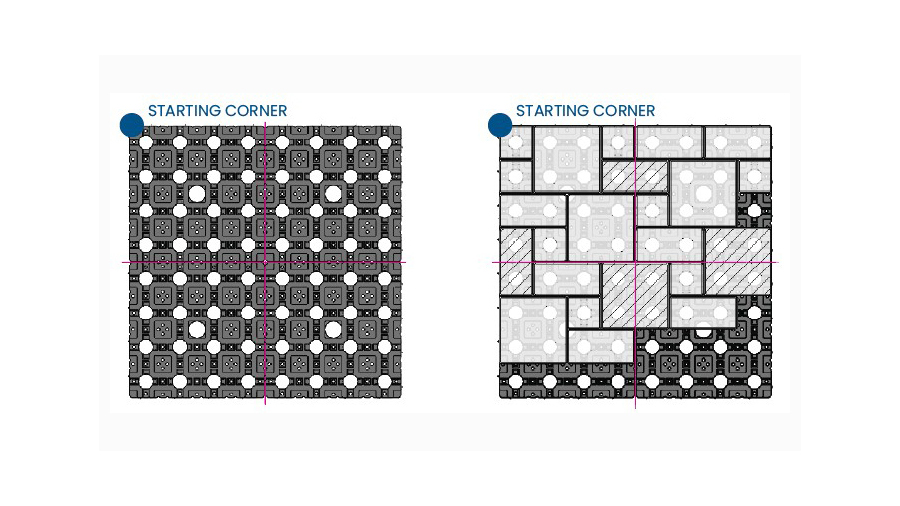
The whole pattern is a series of long, angled rows of the large squares, using the smaller pavers to fill in around those angled rows. One advantage of this pattern is that you'll overlap multiple grids with a range of different tiles to hold things together from all angles.
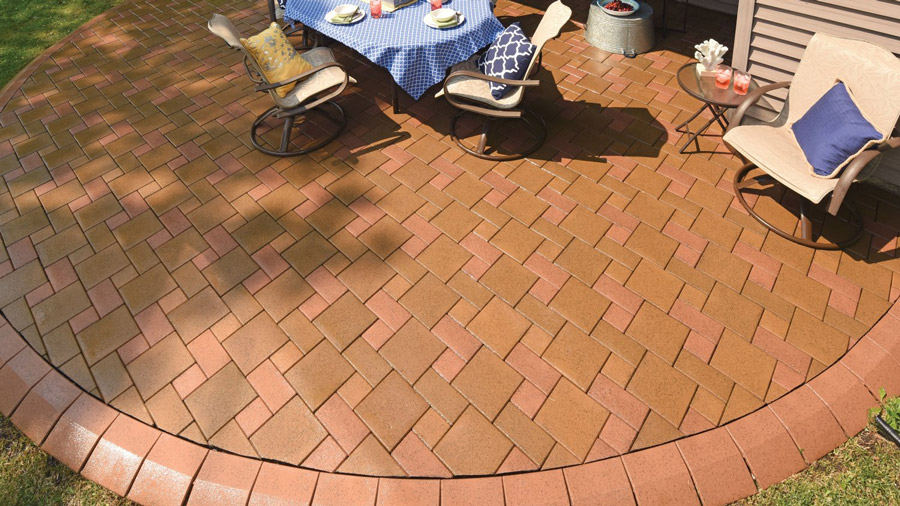
If you're installing a plainweave layout, you'll want to buy and use this ratio of paver shapes:
- 57.1% large square (8x8) pavers
- 14.3% small square (4x4) pavers
- 28.6% rectangular 4x8 pavers
You can always give our team a call at 1-888-824-5316 to plan your project and make sure you get the right amount of each shape and color for the look you want.
Shop PaversOther Paver Patio Design Ideas
Beyond your choice of paver patterns, there are other ways to personalize your new resurfaced deck or patio, too!
Check out some of our favorite additional customization options:
Use Bullnosing For Clean Edges
You can give the edges of your space a nice clean finish with bullnose border pavers:
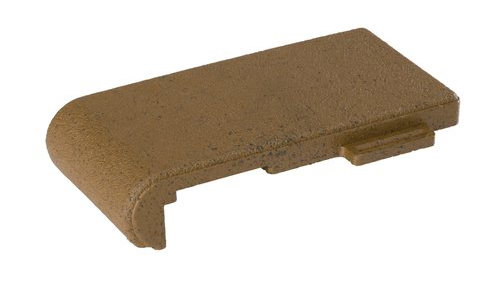
These rounded-off border pavers are perfect for the boundaries of your patio, or for sleek nosing on steps:
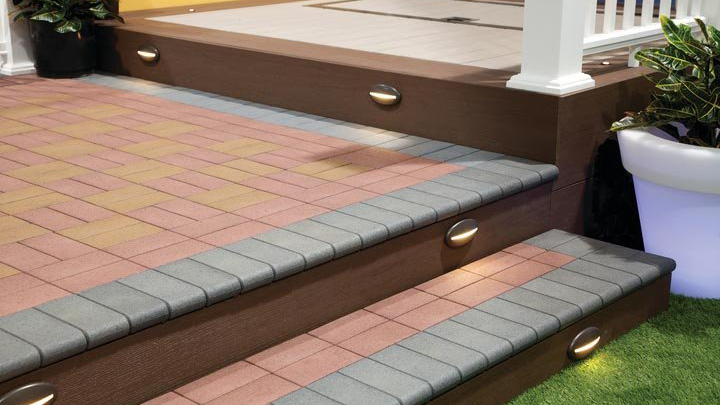
Cut Tiles For Curves Or Unique Shapes
The great part about using Aspire Pavers is that the recycled material is incredibly easy to cut and trim. If your space isn't a perfect square or rectangle, you can fill the entire area by cutting curves or notches into your pavers:

We recommend using a jigsaw or miter saw and a wood-ripping blade with a low tooth count to create the cleanest cuts.
Combine Patterns For More Complex Looks
Instead of sticking with one paver pattern, you can combine multiple patterns into the same space for an even more eye-popping look.
Check out some of these amazing combination patterns below:
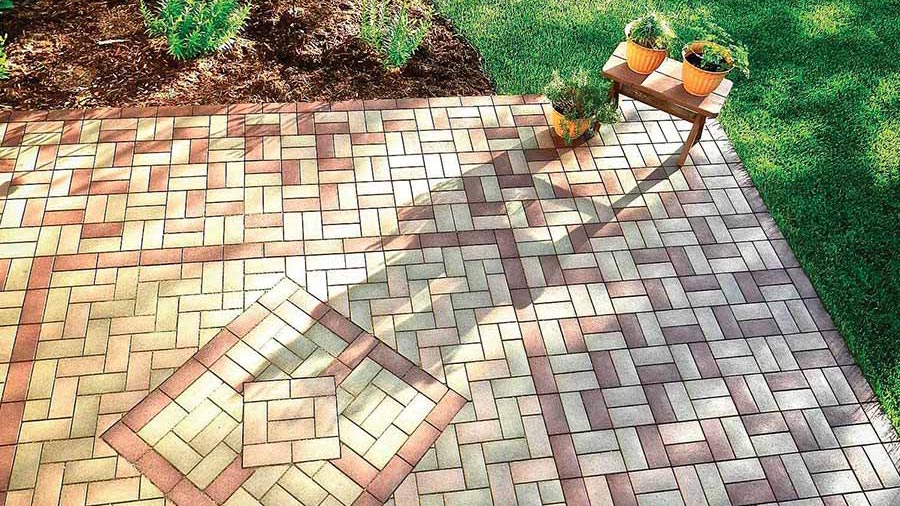
This detailed patio features a basketweave pattern around the outside, with a herringbone pattern within and then a few decorative square and diamond layouts inside that.
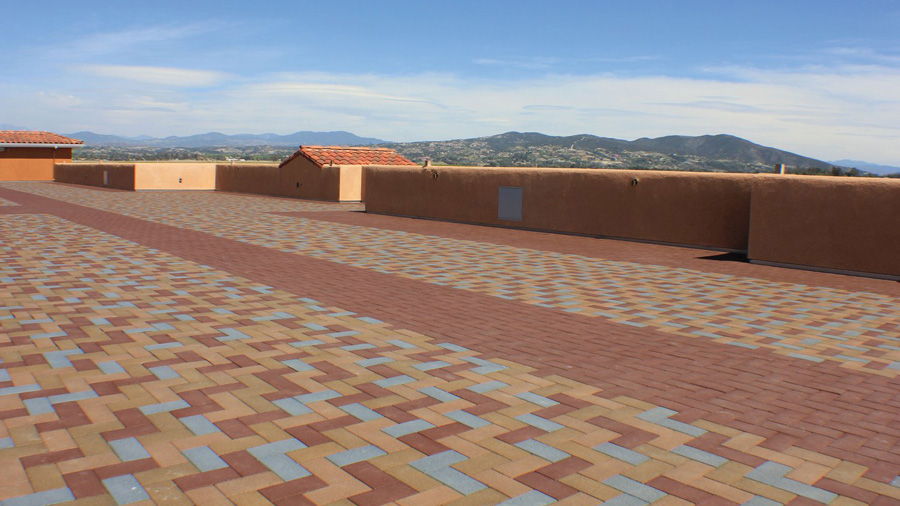
This rooftop deck is mostly made up of a bright, multicolored herringbone pattern, but creates a distinct walkway by breaking the herringbone pattern with stretches of a single-color herringbone.
What to Consider When Selecting Paver Patterns
Choosing the right paver pattern affects the durability, maintenance, and overall look of your outdoor space. Whether you're working on a paver patio or deck, the pattern you select can enhance visual appeal, improve functionality, and impact long-term upkeep. Here's what to keep in mind when selecting the best paver pattern for your project.
1. The Style of Your Space
Your paver design should complement the architectural style of your home and surrounding landscape. If you're working with a classic or traditional look, paver patterns like herringbone or basketweave deliver timeless charm. For a modern or contemporary feel, sleek linear or modular paver designs create clean lines and a streamlined aesthetic. Looking for something with a bit more character? Randomized paver pattern ideas can add an organic, natural stone feel to patios and pathways.
2. Traffic and Functionality
Different paver patterns handle foot and vehicle traffic in unique ways. For high-traffic areas like main walkways, opt for interlocking patterns like herringbone, which offers superior stability and prevents shifting over time. In paver patterns, functionality is more about comfort and looks — so you can explore softer, flowing layouts like running bond for a relaxed, inviting feel.
3. The Size and Shape of Your Space
The right paver pattern can visually expand or define a space. In small patios, larger pavers or simple running bond layouts can make the area feel bigger and more open. On the other hand, intricate deck paver patterns or multi-directional designs work well for larger spaces, adding texture and depth without feeling overwhelming.
4. Material and Color Selection
Your choice of paver patterns should align with the color and material of your pavers. Lighter tones create an airy, open feel, while darker shades offer a bold, dramatic look. Blending multiple colors within a pattern can create depth, while a monochromatic design offers a sleek, cohesive finish. When selecting materials, factor in slip resistance and climate durability — especially for paver designs for patios in wet or freeze-thaw environments.
5. Installation and Budget
Some paver patterns are easier and more affordable to install than others. Running bond is simple and requires fewer cuts, making it a budget-friendly choice. In contrast, intricate patterns like herringbone or circular layouts require more precision, additional pavers, and often professional installation — raising costs but delivering a truly custom look.
6. Long-Term Maintenance
Maintenance needs vary depending on your chosen paver pattern. Patterns with fewer joints, like large-format or modular layouts, require less weed control and sealing. More complex patterns with tight interlocking designs, such as herringbone or basketweave, provide better long-term durability but may require occasional re-leveling if installed over an uneven base.
Whether you want paver pattern ideas for a patio or deck, the right design should balance looks, function, and long-term durability. Consider your space size, traffic levels, and maintenance preferences when choosing a layout, and don't be afraid to mix and match styles for a unique, high-end look.
Frequently Asked Questions About Paver Patterns
You have questions about paver patterns, and we have the answers. Here are some common things people ask about.
Do certain paver patterns help with water drainage?
Yes, open-joint or permeable paver patterns are designed for better drainage by allowing water to pass through gaps into the ground. If you live in an area with frequent rain, consider patterns that prevent pooling and reduce runoff. Avoid tightly sealed patterns without proper slope, as they can trap water.
How do I keep paver patterns from shifting over time?
It's easy to prevent shifting when you use the grids that are included with Aspire Pavers.
How do I choose the right paver color to complement my pattern?
Your paver color should enhance the overall pattern and fit the style of your home. Lighter pavers make small spaces feel larger, while darker tones add depth and contrast.
Knowledge Center
Tips and tricks on deck building and designing from the experts here at DecksDirect!


